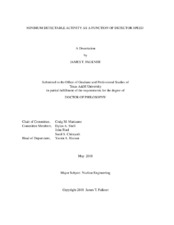| dc.contributor.advisor | Marianno, Craig M | |
| dc.creator | Falkner, James T | |
| dc.date.accessioned | 2020-09-04T19:10:56Z | |
| dc.date.available | 2020-09-04T19:10:56Z | |
| dc.date.created | 2018-05 | |
| dc.date.issued | 2018-05-01 | |
| dc.date.submitted | May 2018 | |
| dc.identifier.uri | https://hdl.handle.net/1969.1/188901 | |
| dc.description.abstract | A radiation detector’s sensitivity is important when designing survey plans. A measure of
sensitivity is minimum detectable activity (MDA) which is the lowest amount of activity required
for a signal to be distinguished above background. It has been known for some time that the efficiency
of a moving detector can be improved by slowing the speed of travel. This decreasing
efficiency at higher speeds results in higher MDAs and thus less sensitive detectors. The effect
of speed on detector efficiency was mentioned in the Multi-Agency Radiation Survey and
Site Investigation Manual (MARSSIM). However, the relationship between speed and efficiency
was not quantified in this manual. This research derived this relationship by modeling detector
efficiency as a function of detector travel speed and fitting a modified four parameter logistic
function (M4PL) to the data. The M4PL function was then verified in a controlled laboratory
setting using a 2 x 2 in sodium iodide (NaI) detector at speeds between 20-120 cm s^-1 and in a
parking lot using a 2 x 4 x 16 in NaI detector at speeds between 10-40 mph. Finally, the M4PL
function was validated using a priori gathered gamma radiation survey data from two aerial systems.
The M4PL function begins with a region of relatively high detector efficiency and ends
with a region of relatively low detector efficiency. In between is a transition region of decreasing
detector efficiency. This decrease is gradual within initial speeds but, quickly steepens, and then
shallows out at higher detector speeds. This general shape was observed for all modeled systems.
The M4PL function was used to develop a relationship between speed and MDA. There
are three uses of the M4PL function. The first is to verify the accuracy of current survey plans.
The second is to optimize survey plans for speed and accuracy. The third is to identify the limits
of detection accuracy based on operational speed. This foundational relationship between detector
speed and detection efficiency has the potential to improve detector performance in various
applications for both the academic and operational fields. | en |
| dc.format.mimetype | application/pdf | |
| dc.language.iso | en | |
| dc.subject | MDA | en |
| dc.subject | minimum detectable activity | en |
| dc.subject | radiation detector | en |
| dc.subject | efficiency | en |
| dc.subject | speed | en |
| dc.subject | velocity | en |
| dc.subject | solid angle | en |
| dc.subject | MCNP | en |
| dc.title | Minimum Detectable Activity As A Function Of Detector Speed | en |
| dc.type | Thesis | en |
| thesis.degree.department | Nuclear Engineering | en |
| thesis.degree.discipline | Nuclear Engineering | en |
| thesis.degree.grantor | Texas A&M University | en |
| thesis.degree.name | Doctor of Philosophy | en |
| thesis.degree.level | Doctoral | en |
| dc.contributor.committeeMember | Shell, Dylan A | |
| dc.contributor.committeeMember | Ford, John | |
| dc.contributor.committeeMember | Chirayath, Sunil S | |
| dc.type.material | text | en |
| dc.date.updated | 2020-09-04T19:10:56Z | |
| local.etdauthor.orcid | 0000-0001-9165-1244 | |


